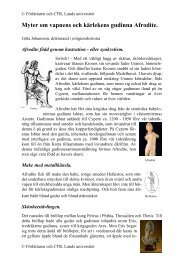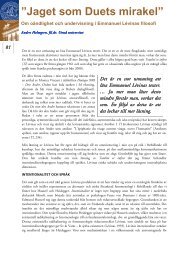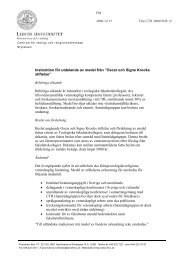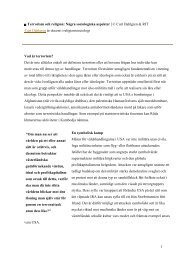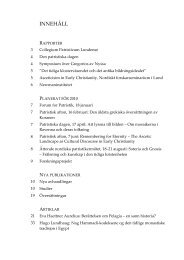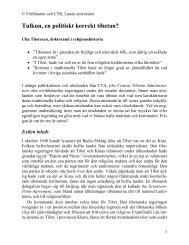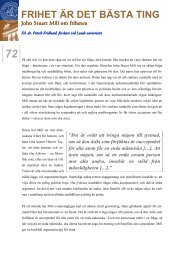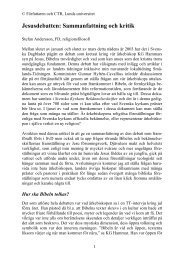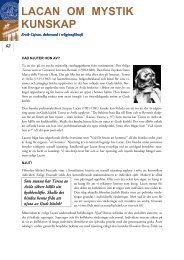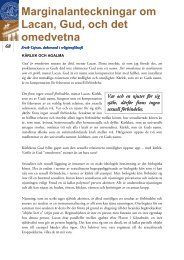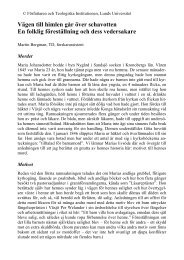Meddelanden 25 (2010) (PDF 2.0 MB - Nytt fönster) - Centrum för ...
Meddelanden 25 (2010) (PDF 2.0 MB - Nytt fönster) - Centrum för ...
Meddelanden 25 (2010) (PDF 2.0 MB - Nytt fönster) - Centrum för ...
You also want an ePaper? Increase the reach of your titles
YUMPU automatically turns print PDFs into web optimized ePapers that Google loves.
1970’s, monastic documents that included personal names known from<br />
Pachomian sources discovered among the cartonnage used to stiffen the<br />
codices’ covers appeared to offer a smoking gun, connecting the collection to<br />
the Pachomians. 7 The smoking gun, however, went up in smoke when one<br />
of the editors of the later critical edition of the cartonnage discounted the<br />
possibility. He held that references to private property, secular concerns, and<br />
contact with the world (particularly with women) evidenced in the monastic<br />
documents precluded their Pachomian origin. 8 My own interest in the<br />
Pachomian movement led me into the debate relatively early, and while I<br />
have at times been placed in the camp of those who argue in favor of a<br />
Pachomian origin, for the most part my position has been less about what<br />
we can claim with confidence about the Pachomians from their literary sources<br />
than about what we cannot claim. Namely, I have argued that the anachronistic<br />
nature of the Pachomian sources precludes certainty with respect<br />
to their claims about the movement at the time when the codices were in<br />
circulation. They cannot alone refute the possibility of the codices’ existence<br />
and use within the Pachomian federation. 9<br />
Recently the pendulum has swung back more strongly against the<br />
Pachomian connection, though from my point of view it sets up the certainty<br />
of the connection as a straw dog to knock down. Avoiding discussion of the<br />
literary sources, Alexandr Khosroyev sought to analyze and identify the<br />
codices’ provenance on a more scientific basis; namely, through the use of<br />
codicological and linguistic data. 10 He contends that the conflated dialects<br />
evident in the texts and the different construction methods used in the<br />
codices’ fabrication point to their origin at different locations among nontraditional<br />
Christians living in various cities throughout Egypt. They belong<br />
in his view to an urban world where speculative religious interests flouri-<br />
7 J. W. B. Barns, ”Greek and Coptic Papyri from the Covers of the Nag Hammadi Texts,” in<br />
Essays on the Nag Hammadi Texts (ed. Martin Krause; NHS 6; Leiden: E. J. Brill, 1975), 9–18.<br />
8 J. W. B. Barns, G. M. Browne, and J. C. Shelton, eds., Nag Hammadi Codices: Greek and<br />
Coptic Papyri from the Cartonnage of the Covers (NHS 16; Leiden: E. J. Brill, 1981), 1–11.<br />
9 James E. Goehring, “New Frontiers in Pachomian Studies,” in The Roots of Egyptian<br />
Christianity (ed. Birger A. Pearson and James E. Goehring; SAC; Philadelphia: Fortress<br />
Press, 1986), 236–57; reprinted with an addendum in Ascetics, Society, and the Desert: Studies<br />
in Early Egyptian Monasticism (ed. James E. Goehring; SAC; Harrisburg, PA: Trinity Press<br />
International, 1999), 162–86; idem, “Monastic Diversity and Ideological Boundaries in<br />
Fourth-Century Christian Egypt,” JECS 5 (1997): 61–84; reprinted in Ascetics, Society, and<br />
the Desert, 196–218; and idem, “The Provenance of the Nag Hammadi Codices once more,”<br />
in Asectica, Gnostica, Liturgica, Orientalia: Papers Presented at the Thirteenth International<br />
Conference on Patristic Studies held in Oxford 1999 (eds. M. F. Wiles and E. J. Yarnold;<br />
Leuven: Peeters, 2001) = StPatr 35 (2001): 234–53.<br />
10 Alexandr L. Khosroyev, Die Bibliotheque von Nag Hammadi: Einige Probleme des<br />
Christentums in Ägypten während der ersten Jahrhunderte (Arbeiten zum spätantiken und<br />
koptischen Ägypten 7; Altenberge: Oros, 1995).<br />
∙ 63 ∙



